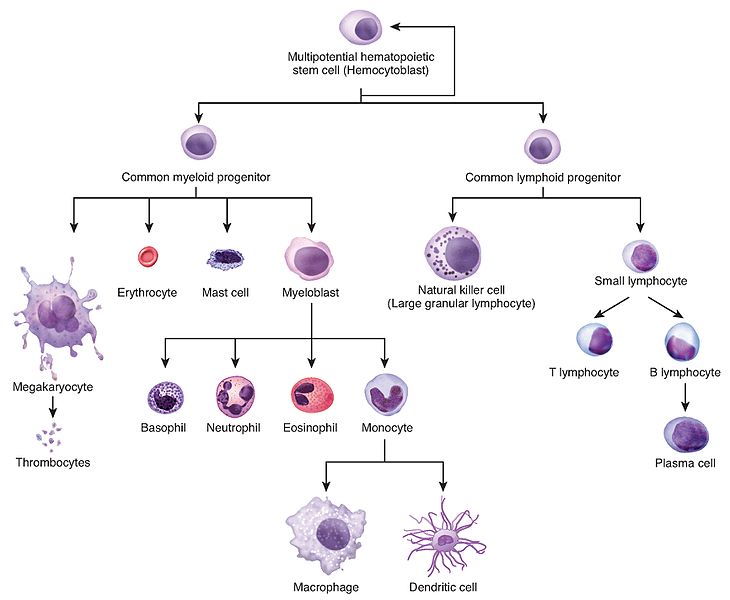Difference Between Hematopoiesis and Erythropoiesis
Table of Contents
Key Difference – Hematopoiesis vs Erythropoiesis
Blood is the main fluid which circulates in the principal vascular system of all vertebrates. Blood transports oxygen and necessary substances to the functioning cells and transports waste and carbon dioxide from the cells. It is composed of plasma and blood cells named red blood cells, white blood cells, and platelets. A mature blood cell possesses a short life span. Hence the synthesis of billions of blood cells is daily needed to meet the requirement of the circulation. Hematopoiesis is the process which synthesizes mature blood cells of an organism. Hematopoiesis is classified into five major classes. Erythropoiesis is one category among them. Erythropoiesis is the process that produces red blood cells (one type of blood cells). Thus, the key difference between hematopoiesis and erythropoiesis is that hematopoiesis is the overall process of the production of blood cells while erythropoiesis is a part of hematopoiesis which synthesizes red blood cells or erythrocytes.
CONTENTS
1. Overview and Key Difference
2. What is Hematopoiesis
3. What is Erythropoiesis
4. Side by Side Comparison – Hematopoiesis vs Erythropoiesis
5. Summary
What is Hematopoiesis?
The word ‘hemato’ means blood and ‘poiesis’ means make. Thus, the term hematopoiesis refers to the process of continuous production of blood cells. It is an essential cellular process. There are three major types of blood cells: red blood cells, white blood cells, and platelets. The overall process which synthesizes all these blood cell types is known as hematopoiesis. Blood cells are made in the bone marrow of bone (central cavity of the bone composed of spongy tissue). Therefore, the bone marrow is the site of hematopoiesis. This process initiates from the hematopoietic stem cells (hemocytoblasts). Hematopoietic stem cells are pluripotent cells, i.e., they can produce all progeny of blood cell types. They also have the ability of self-renewal. These stem cells can be specialized into two lineage cell types called myeloid cells and lymphoid cells. Thus, all blood cells belong to these two types. Myeloid cells are six major types named erythrocytes (red blood cells), megakaryocytes, monocytes, neutrophils, basophils, and eosinophils. Lymphoid cells are two major types named T-lymphocytes and B-lymphocytes.

Figure 01: Hematopoiesis
What is Erythropoiesis?
Red blood cells or erythrocytes are essential for the transportation of oxygen from respiratory organs to cells and tissues of the body and removal of carbon dioxide and waste from the tissues and cells. The lifespan of a red blood cell is about 120 days. Hence, it is necessary to synthesize red blood cells continuously in the body. Erythropoiesis is the process which synthesizes erythrocytes or red blood cells. Since red blood cells are only one type of blood cells erythropoiesis is a branch of hematopoiesis. The term erythropoiesis was derived from two Greek words ‘erythro’ and ‘poiesis’ referring ‘red’ and ‘to make’ respectively. The site of the erythrocytosis of an adult person is the bone marrow.
A hemocytoblast or a hematopoietic stem cell first becomes a myeloid cell (multipotent cell). Then it is specialized into a unipotent cell and later into a proerythroblast. Proerythroblast is converted into erythroblast, polychromatophilic, and orthochromatic, respectively. At this stage, these orthochromatic cells leave the bone marrow and enter the blood and become a mature erythrocyte (mature red blood cell).
Erythropoietin is the hormone which plays a key role in erythropoiesis. It is produced by the kidneys and it induces the production of red blood cells in response to low levels of oxygen in body tissues. Fibronectin (extracellular matrix protein) is also important for red blood cell production.

Figure 02: Erythropoiesis
What is the difference between Hematopoiesis and Erythropoiesis?
Hematopoiesis vs Erythropoiesis | |
| Hematopoiesis is the overall process of blood cell production. | Erythropoiesis is the process of red blood cell production. |
| Categories | |
| There are five categories of hematopoiesis. | Erythropoiesis is a category of hematopoiesis. |
Summary – Hematopoiesis vs Erythropoiesis
Maintenance of a good blood system is essential for life. It depends on the hematopoietic stem cells in the bone marrow. The production of blood cells from hematopoietic stem cells is known as hematopoiesis. Hematopoiesis can be divided into five major branches. Erythropoiesis is one branch of hematopoiesis which is the process involved in the production of erythrocytes. Hematopoiesis and erythropoiesis occur inside the bone marrow of the bones in adult mammals.
Reference:
1. Hattangadi, Shilpa M., Piu Wong, Lingbo Zhang, Johan Flygare, and Harvey F. Lodish. “From stem cell to red cell: regulation of erythropoiesis at multiple levels by multiple proteins, RNAs, and chromatin modifications.” Blood. American Society of Hematology, 08 Dec. 2011. Web. 08 May 2017
2. Jagannathan-Bogdan, Madhumita, and Leonard I. Zon. “Hematopoiesis.” Development (Cambridge, England). Company of Biologists, 15 June 2013. Web. 08 May 2017.
Image Courtesy:
1. “0337 Hematopoiesis new” By OpenStax – (CC BY 4.0) via Commons Wikimedia
ncG1vNJzZmivp6x7pbXFn5yrnZ6YsqOx07CcnqZemLyue8OinZ%2Bdopq7pLGMm5ytr5Wau260xKaYraegpLamv8isZJqmlGLDtHnEq7CtoKKkvbC1xKygrGc%3D